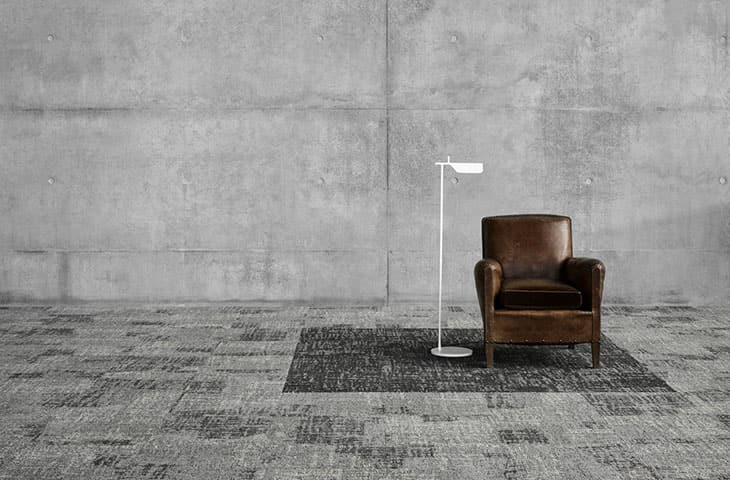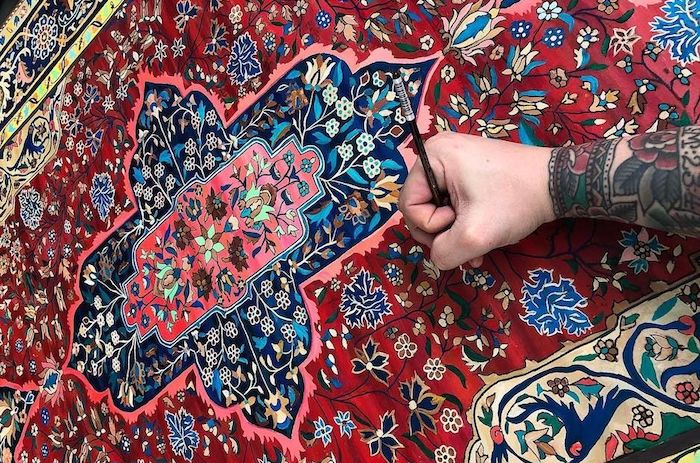Author: M. Z. Sahraei – Kohan Textile Journal
Abstract:
Carpet and art are two inseparable categories of Iranian culture and civilization which have enjoyed a precious position in Iran for many centuries.
The discovery and registration of the first hand-woven carpets and carpet weaving instruments in Iran confirms it. The research and investigation concerning the role of carpet in contemporary art are of high importance.
The creation of various artistic methods in recent years has led to a wide range of revolutions in most arts; and carpet, as contemporary art in Iran and other parts of the world, has responded to the question that what kinds of effects have the recent revolutions had on the role and position of carpet and whether this effect has been in line with the improvement and exaltation of the carpet.
In the contemporary period, the designer artists, following the original principles of Iranian designs and carpet designs of previous periods, have created new designs with the special structure and characteristics of the contemporary era and modern and conceptual designs got into the country’s carpet designs and doubled the previous works beauty.
Research background:
Research methodology: this research is compiled as descriptive-analytic research, in which documentary data is used.
Introduction:
Carpet is among the most important symbols of elegance, art and the beautiful soul of Iranian society. Since ancient time, Iranians have been interested in creating abstract patterns to decorate the cracks and elate pillars and decorated their big buildings’ ceilings with geometric patterns and the broken patterns and convoluted squares and transversal lines.
The artists designed decorated flowers and trees’ patterns on the walls and pillars and sometimes these patters were sacred and respectful. The patterns were including pine pattern with a mixture of patterns in woolen or herbaceous ground cloth. The patterns of walls and ceilings were brought to the homes’ ground clothes and the first woven carpet in the Achaemenian period, named Pazeric, in ancient time (Achaemenian 321-55 B.C.E) and then Sayan period (336-652 B.C) then Islamic period, Teimorian- the Safavid period and then in the contemporary period which was full of new changes in carpet designing.
The most changes in designing the map of the carpet have been made in the contemporary period. Following the main rules of carpet designing, many new patterns and drawings are created, especially in the aspect of modern and traditional and the mixture of modern and traditional and other new and modern methods.
Carpet and contemporary art
The Iranian carpet is one of the cognitive earmarks of our country. Each handwoven carpet is the narrator of a different story and also the result of boarding efforts. In this paper, we have talked about the Iranian carpet, different types of patterns and contemporary designing and its influence on the handwoven and moquette.
The Iranian carpet, which is the ornament of Iranian houses, is globally famous and Iranian carpet, a heavy cloth to decorate or household use, is one of the most original characteristics of Iranian culture and art and also one of the leading exports. Iranian carpets are woven by tribes and educational workshops.
It is the narrator of Iranian arts and cultures, traditions, people and their lifestyles. Because of its durability, glaring textures, strong colors and exact patters, the Iranian handwoven carpet is very famous. They are known by the natural colors, traditional tribal patterns and also modern patterns which follow traditional designing methods. The cities of Isfahan, Naein, Kashan, Tabriz, Mashhad, Kerman and Qom are famous for their carpets.
In 2010, the Iranian carpet was placed in the list of UNESCO cultural heritage list for its beautiful designing. The traditional carpet weaving skills in Fars and Kashan were placed in the list of the representative of intangible heritage of UNESCO. The Iranian carpet’s history dates back to several periods and enjoys the antiquity of more than two thousand years of Parizik carpet which was discovered in 1949 and it is probably for Achaemenian craftsmen or the place in which it was found.
The antiquity of Iranian carpet dates back to the Sassanids after Islam, the Timurid, and the Safavid. In the latter, the relief pattern and the use of miniatures show a remarkable change in carpet designing and cloth weaving the late 15th century. After that, in Afsharieh dynasty, and then by the establishment of Iran carpet company by Reza Shah Pahlavi in 1925, the Iranian carpet and its patterns moved toward the contemporary period and by the beginning of the contemporary period, the previous attitudes toward art changed and the artists started to create artistic works with a new outlook.
The contemporary art is rooted in the intellectual foundation of modern art and it is stabilized thanks to the advent of modern methods of new and beautiful artistic expression. From historical perspective, these arts include the shape structure movements which have arisen after the 60s in the leading artistic page of the whole world. As a result, the being contemporary interpretation of the art not only refers to a historical passing, but it also refers to a theoretical and media divergence.
Consequently, the modern art reached its peak after a century of ups and downs between 1860 to 1960 and whatever that emerged out of that time was named the contemporary art. The issue which has caught the most attention of the researchers is the developments of the carpet in the cases of designing and weaving, rather than how the carpet is presented as an idea or the instruments in contemporary art. Therefore, paying attention to this issue and investigating the role of carpet in the new artistic languages and also investigating its various functions in the common era.
Introducing the historical backgrounds of traditional and contemporary patterns
Human beings express their inner interpretation of the world by the pictures and array shapes. Hence, any picture or pattern is illustrating an inner objective or a factor to communicate with the creator of the work. These pictures have been working as the foundation to grow and blooming of the artistic talent of the Iranian imaginative minds. The Iranian artist and the creator of the artistic works is inspired by the nature and he has never imitated anything.
In this manner, we can classify the diversity of traditional patterns in this way: 1) Arabesque motif: A. broken patter, B. circular pattern. 2) the imaginary patterns. The old artists and designers first tried to draw geometric patterns on different objects and then tried to fix different lines and mixed them together and to draw more complicated works, they extended natural patterns and pictures. The initial patterns were a reflect of agricultural activities and the lifestyle of primary life in Iranian highland; patterns of mountain and the sea and the trees, and these patterns were more on the pottery.
We can refer to the geometric and animal patterns, hunting drawings and the octameros that are found in regions of Shoush, central plain of Iran, the Kashan Likak region, Khorovin, Lorestan and Zivieh that are mostly carved on the plates and decorative objects.
The patterns are mostly in black, and most of the objects are golden or silver. Therefore, the features of the patterns in the primary civilizations’ patterns can be summarized in the following points:
1- the role of herbaceous patterns is more limited in comparison with the human and animal patterns.
2- in the middle of herbaceous patterns we see less of the main space of the works.
3- the herbaceous patterns have the most use in the margin or decorative ribbons.
4- the usage is in repetition and symmetry way.
5- we don’t see variety in herbaceous patterns.
6- the simple geometric patterns are affected by the agricultural and breeding life like the earth, mountain, etc.
Historically speaking, the Achaemenian art is a combination of Maddi, Ashouri, Babeli and Greek Uratu and Eillami. And because Achaemenian were in control of all these regions, they could capture their art. Persepolis is the great treasure of Achaemenian.
The main feature of the Achaemenian patterns are as follows:
1- the use of human, animal and herbaceous patterns.
2- the division of the template and the drawing of the margins and the main part.
3- common herbaceous patterns are including the cypress tree, and lotus.
4- using the transmission, reversed symmetry in multiplication of the patterns.
5- the limitation of herbaceous patterns.
6- elegance and exactness in presenting the work.
After that we had the Arascians who were inspired by Greek art and the most gathered works of this period are including wall paintings, geometric, human and herbaceous patterns plasterwork. The geometric and herbaceous patterns cover the most decorative aspect and it is done with repetition and symmetry.
The Sassanid drawings are taken from the Achaemenian drawings and the features of these drawings are including:
1- herbaceous patterns (human and animal).
2- the variety is little in herbaceous patterns.
3- the herbaceous patterns are used in the margin of the drawings.
4- the repetition and symmetry method.
5- the hooked and circular herbaceous patterns are practical in Islamic period.
The advent of Islam and its extension in Islamic lands led to the extinction of the Sassanids and the Zoroaster religion was replaced by Islam which deeply influenced all aspects of Iranians, art in particular.
These are the features of drawings and patterns of Islamic period (from the begging till the end of the Seljuks period):
1-the wide use of various Kufi writings and the mixture of Kufi writings with the Arabesque patterns and the drawings of different Kufi writings, based on their patterns.
2- the complexity of the patterns.
3- decorating the financial aspect of Arabesque patterns with geometric patterns.
4- initiations in the mixture of patterns and the various use of them in star frame, Chalpia, margin and the main parts.
5- the mixture of the writing, human, animal, Arabesque and geometric patterns with each other in decoration the practical works and objects.
6- the influence of literary themes and religious concepts in decorating the works.
7- using the patterns in circular shapes and the use of Arabesque patterns with short and pressed bows after the Islamic period, the Mongol, Patriarch and the Teimori periods and accordingly, we will see the differences in Arabesque and writings.
In Safavid period, the big Arabesque bows are created with elegance. In Qajariyeh dynasty, we witnessed a decrease in the originality of the traditional patterns and also the entrance of the Turkmans led to the new patterns which didn’t have any background in Iran. In the contemporary period, these patterns have a wide usage in handicrafts and artists are working in different cities like Tehran, Isfahan, Mashhad, Shiraz, Kerman and Tabriz. Among the works of these designer artists, we can spot creative works which are competing with the previous samples.
Conclusion:
Investigating and researching about the carpet designing art in the contemporary period of Iran is of high importance and considering the background of the pattens and the nations and the use of them in artistic works, from plates to wall paintings and architecture of the old buildings and new buildings and drawing these patterns and methods on the cloth and of course after that on ground-clothes and the carpets in Iran has led to the creation of new styles and the creation of various artistic patterns in the recent time.
We have seen huge revolutions in most arts and carpet is not an exception in this manner. The contemporary artists have created a lot of changes in the patterns and designing of the carpets and guided them toward a new tradition and huge change by using the traditional artistic methods and original Iranian patterns. They have preserved the sacredness of traditional designing and they have also led them toward a new way created new conceptual patterns which are still open to improvement and new changes and in a short future, we will see newer and more beautiful changes in carpet designing.


























